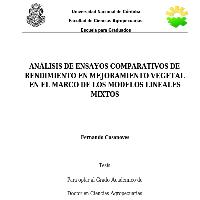Resumen
- Esta tesis se enmarca en el área de estadística aplicada e involucra la evaluación de metodologías estadísticas para el análisis de información en programas de mejoramiento genético vegetal. Se considera la modelización de datos de ensayos comparativos de rendimiento (ECR). Los ECR suelen repetirse en múltiples ambientes (localidades y/o años) debido a la existencia de interacción genotipoambiente, siendo común observar variación espacial en función de la ubicación de las parcelas en el campo y diferentes niveles de precisión entre ensayos conducidos en distintos ambientes. El objetivo de este trabajo es proponer estrategias de análisis de ECR multiambientales que permitan: 1) elegir, en etapas tempranas, el material genético experimental que debe continuar en proceso de evaluación, 2) recomendar, en etapas avanzadas, los genotipos con mejor desempeño y 3) contemplar la correlación espacial entre parcelas y la heterogeneidad en precisión de los ensayos conducidos en diferentes ambientes. Las metodologías investigadas consideran el marco teórico del modelo mixto lineal general. Utilizando ECR del Programa de Mejoramiento de Maní EEA-Manfredi-INTA (Argentina), se ilustran diversos aspectos de la modelación estadística y se comparan resultados. Para responder al primer objetivo se evaluó la potencialidad del uso del mejor predictor lineal insesgado (BLUP) para la elección de líneas experimentales. Como medida del desempeño que un genotipo podría tener en futuros ECR se utilizaron BLUPs de efectos aleatorios de genotipo estandarizados por su error de predicción, basados en uno y dos años de ECR. Los resultados muestran que los BLUPs estandarizados, aún obtenidos a partir de información de un año de ECR, tienen más capacidad predictiva que las medias de genotipo. En relación al segundo objetivo, se analizaron ECR multiambientales por año mediante modelos de efectos fijos sobre tablas de datos completas y a través de los años mediante modelos mixtos aplicables a tablas de datos incompletas (i.e. no todos los genotipos en todos los años). Los modelos fueron ajustados con varianzas residuales homogéneas y heterogéneas a través de los años. Los resultados permitieron identificar cultivares superiores y confirman la existencia de un único mega-ambiente para la identificación de cultivares con mayor vi potencial de rendimiento en la región manisera Argentina. Considerando la necesidad de contemplar la correlación espacial entre parcelas y las diferencias en precisión de los ensayos de un ECR multiambiental se evaluaron simultáneamente, sobre diversos ECR, una decena de modelos estadísticos y se discutió la equivalencia que existe entre algunos modelos mixtos espaciales en el contexto particular de los ECR multiambientales. Los resultados sugieren que el modelo con estructura de error estacionaria anisotrópica AR1AR1 y varianzas residuales heterogéneas constituye la mejor alternativa de análisis para ECR multiambientales.
- This thesis is in the area of Applied Statistics and involves the evaluation of statistical methodologies for the analysis of information in plant breeding programs. The modeling of data from yield multi-environments variety trials (MET) is considered. Yield variety trials are usually repeated in several environments (locations and/or years) due to the genotype×environment interaction, and it is common to observe spatial variation according to the location of the plot in the field, and different levels of precision among trials conducted in different environments. The objective of this work is to propose strategies for the analysis of multi-environment yield variety trials which permit: 1) to choose, at early stages, the experimental genetic material to continue the evaluation process, 2) recommend, at advanced stages, the genotypes with better performance, and 3) to consider the spatial correlation among plots and the heterogeneity in the precision of trials conducted in different environments. The methodologies reviewed consider the theoretical framework of the general linear mixed model. Different aspects of the statistical modeling process are illustrated using yield variety trials form the Peanut Breeding Program EEA-Manfredi-INTA (Argentina). Results from these analyses are compared. In order to address the first objective, the performance of the best linear unbiased predictor (BLUP) for selecting experimental lines was evaluated. The BLUP´s of the random effects of genotype, standardized by their prediction error and based on data from one and two years of variety trials, were used as a measure of the performance that a genotype could have in future trials. The results show that the standardized BLUP´s, even the ones obtained from one year, have more predictive ability than those obtained using fixed effects models for complete data tables, and mixed models for incomplete data (i.e., when not all genotypes were present in all years). The models were adjusted with residual variances which were homogeneous and heterogeneous through time. The results identified superior cultivars and confirm the existence of a single mega-environment for the identification of cultivars with better yield potential in the peanut growing region in Argentina. Ten different statistical models were used to account for the spatial correlation among plots and the differences in precision among different viii trials. The equivalence among several of the spatial mixed models in the particular context of multi-environment trials is discussed. The results suggest that the model with anisotropic stationary AR1×AR1 with heterogeneous residual variances is the best alternative for these multi-environment yield trials.
